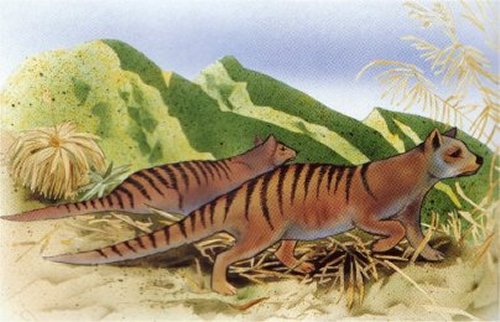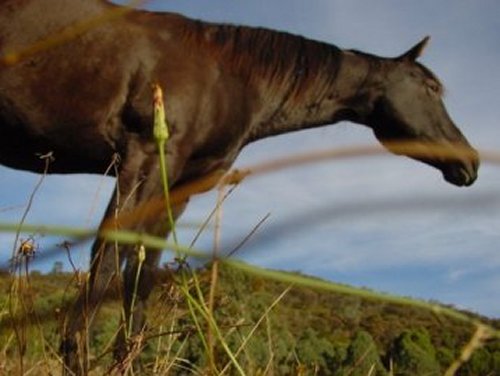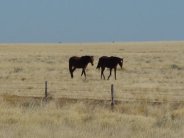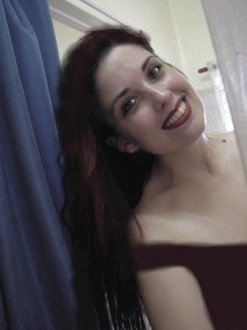AUSTRALIAN POETRY: UNTETHERED HORSES
By Coral Hull

Thylacinus cynocephalus - "The pouched dog with the wolf's head".
Welcome to the sixth issue of Thylazine: The Australian Journal of Arts, Ethics & Literature.
I have always wanted to produce a magazine that is both artistic, ethical and far-reaching. Yet for one reason or another, I have never had the finances, contacts or knowledge to do such a thing until the electronic revolution occurred and we had the internet and cyberspace. As a working-class female poet from a disadvantaged background living in the western suburbs of Sydney, Australia, it is still the only way much of my creative work has not disappeared, or been left at the whim of the commercial, cultural and political elite.
There is much talk about the state of poetry in Australia, as one by one publishers close their doors on poets. While poets in other countries are arrested and even murdered, in Australia they suffer the slow death of being neglected and ignored.

|
The imprisonment is cultural isolation. Poets are allowed to think that they are insignificant when it comes to their work, their insights and their contribution to culture. Despite the old argument, this has little to do with the way poetry was taught in schools and everything to do with the poetic voice that deeply radical and compassionate creative conscience - being silenced and slowly but surely extinguished. |
[Above] Grey Horse, Dajarra, Queensland, Australia. (Photo by Coral Hull, 2002)
This does not mean that all poetry must be political. While not all poets are radicals or adopt strong stances in their work, as our society would have it, we have all been placed in the same boat down under. It is our choice whether we sink or stay afloat. Even the most conservative, lightweight and fashionably non-political poets remain virtually unknown. This is primarily because poetry is political by its very nature, by its very existence. It is not simply an insignificant social club for hobbyists. The act of creativity is courageous, important and completely necessary. At its best it reminds us of the eternal nature of the Tasmanian Thylacine, mysteriously sighted in a southern or even mainland wilderness - still living, perhaps gone forever but ever-present. I will leave you to think about that.
Why does this culture choose to ignore the voice of its poets? Why do we bicker amongst ourselves and remain at the bottom of the literary and artistic pile, when life on earth is on the brink of an irreversible global environmental crisis? Where is our artistic and moral integrity? Where is our courage - our pens that are mightier (and more useful) than swords? As Australian poets, we have a lot more to give to others, than we are led to believe. We may be well aware that we are working against the odds. At such times will we remember what inspires us?

[Above] Cody, Duck Crossing, Rylstone, New South Wales, Australia. (Photo by Coral Hull, 2001)
Over 6,000 years ago the horses of the world where unridden and untethered. They wandered in sociable herds along the plains and valleys in the northern hemisphere at the whim of nature and their own spirits. Now as a species they are property, marketable commodities, slaves, merely iconic, institutionalised, items of novelty and entertainment. They are awarded no more rights than is a stone.
They are tortured and exploited by the racing industry, intensive farms, slaughterhouses, shot down by helicopter or simply left to starve to death in neglected paddocks. Yet within the eye of that weary carriage horse, whose hoof is shattered by persistent pounding along the hard city streets of Melbourne or Chicago, I am witness to the spirit of all horses from all times. I see the horse as it is, but also as it once was or as it might be again. If you want to read some truly powerful poetry, look into the eye of a horse and it is written there. It will give all answers to all questions. Even while enslaved the gaze will be noble. It will be both tragic and beautiful. It will remind us of why we are poets.
When art becomes institutionalised and put into the hands of an elite - it finds temporary death. In this frozen form that resists change, it can only be accessed and maintained by the socially conservative - the teachers of world annihilation that will spoon feed it back to us in sizeable portions. It becomes like those wooden horses on a carousel that go round and round with their painted eyes that say they are of "the horse", but that in reality provide no substitute for what we know to be true. As a child I was terrified to cling to the top of horses. All horses were like mountains that were too high. I knew from an early age the feeling of being completely insecure and out of control. Like many others, I struggled with my feelings of wanting to be close to horses and being afraid to ride on their backs. The solution is obvious now - to walk beside them, to be in awe of their wisdom and to respect their freedom.

|
In this way I am closer to the grace of horses than ever before. As a child, I believed that the old broken-down draught horse, or the wooden carousel horse, would somehow come to life and break out of its farmyard or merry-go-round imprisonment, in order to gallop off into the night, or even to grow wings and take flight into the stars as horses who are magical are able to do. For as any unicorn or Pegasus or other horse of mythology knows, the solution was always integrity and freedom. This world has inspired us to write. Our tools are creativity and compassion. We owe this to the world. |
[Above] In the Language of Geppetto, from Blue Fifth (Photo by Cheryl Dodd, 2002)
Thylazine has leapt off the edge of material confinement and into cyberspace where it thrives. Cyberspace is a concept where art and literature can exist untethered and where creative integrity can live or die as much as it lives or dies within each of us. In cyberspace poetry and other art can be accessed and impact the world, even more than it could have before. Thylazine doesn't need anywhere physical to live. It has a home with The Envirolink Network where it cannot be hunted down and made extinct.
Australian poetry is not dead, merely as endangered as the earth itself. But with nurture it can be as those horses once were 6,000 years ago - graceful and wild and free. This is because the internet is about untethering art - just as we must untether horses from their roles as slaves within this society. We must do both in order to access the creative spirit within ourselves. Let us say this to each other: You are more than an Australian poet. You are a human being, a sentient animal, a resident and conscience of the earth. You are not my enemy. You are my friend. Together our words and hearts can make a difference to the world. Please make yourself at home in this issue of Thylazine.
Dr. Coral Hull (Editor)

|
Thylazine thanks the following people for their generosity: Anonymous ($50.00) and Anonymous ($200.00) towards Thylazine No.9 and The Thylazine Foundation's charitable work.
A special thanks to the contributors; Jordie Albiston, Melissa Ashley, Helene Brophy, Lee Cataldi, Paul Cliff, Jillian Crider (cover art), David Dixon, Rebecca Edwards, Diane Fahey, the late Dorothy Hewett, D. J. Huppatz, Coral Hull (that's me), John Mateer, Billy Marshall Stoneking, John Mateer, Jenni Mitchell, Les and Valerie Murray, Peter Porter, Tom Shapcott, Komninos Zervos and the many artists and photographers whose work is included in this issue. |
[Above] Horses, Barkly Hwy, Queensland, Australia. (Photo by Coral Hull, 2002)
And others; Stephen Booth, C. Campbell from The Thylacine Museum, Cheryl Dodd at Blue Fifth, Iain Fraser, the late Philip Hodgins, Kindi and Binda who renew my dreams on a daily basis, "Shamrock" and "Judy" the graceful donkeys at The Good Samaritan Donkey Sanctuary, The McDonald Bothers from Digby, the eleven black angus cows from Rylstone: Molly, Emma, Caliban, Millie, Amanda, Monica, Stevie, Maggie, Ruby, Rachel and Faith. (r.i.p. Kinsella, 2001), the untamed wildlife of the Galapagos Islands, and lastly to Josh, Marla and The Envirolink Network (Pennsylvania, USA) without whose support and assistance this website would not be possible.
About the Writer Coral Hull

|
Coral Hull is the author of over 35 books of poetry, prose poetry, fiction, artwork and digital photography. Born in 1965 she was raised under disadvantaged circumstances in the working class suburb of Liverpool in Sydney's outer west. Coral became concerned with issues of social justice and spirituality from an early age. She wrote her first poem about a rainforest at age 13. Coral became an ethical vegan and an animal rights advocate who has since spent much of her life working voluntarily on behalf of animals and the environment, both as an individual and for various non-profit organisations. She is also the Executive Editor and Publisher of Thylazine; an electronic journal featuring articles, interviews and visual art of Australian poets, writers, artists and photographers. Coral holds a Master of Arts Degree in Creative Writing from Deakin University in Victoria. She also holds Doctor of Creative Arts Degree (Creative Writing Major) from the University of Wollongong in New South Wales. An extensive biography, list of publications, festivals, interviews, articles and reviews are online. Coral lives in Sydney with her two dogs Binda and Kindi. |
[Above] Coral Hull, Elliot Hotel, Elliot, Northern Territory, Australia. (Photo by Coral Hull, 2001)
I Next I
Back I
Exit I
Thylazine No.6 (September, 2002) |



